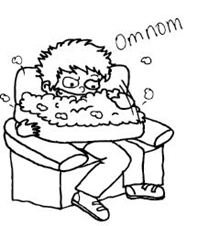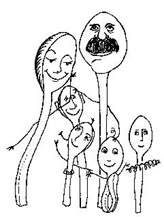Hints and tips on eating
Portion size and frequency

As explained in the blending section above, a puréed meal will blend down to a much smaller portion and yet still be filling. So a puréed meal will always look smaller on the plate. However, even when Alex was able to swallow a ground or minced meal, I kept portion sizes small for him. A big meal on a plate can look very daunting or off-putting for a dysphagic patient who often regards eating as something of a chore and a rather unpleasant experience. If new “habits” have to be formed to ensure safer eating, it is easier for the patient to concentrate on these new methods for a shorter period of time with a small meal than with a large one. Therefore, eating little and more often can be safer and less stressful all round.
Timing
Although, previously, we had always had our main meal in the evening, we found it best to have it at lunchtime as Alex was not so tired and often his medication had not worn off so much. He could concentrate better and so we had fewer choking episodes at lunchtime.
Speed of eating
Eating became a real ordeal, even a small portion. Alex took a long time to eat a meal (which previously would have taken him a few minutes) as he had to force himself to eat slowly which he found very frustrating. My rule for myself was not to get upset that his meal had gone cold or he did not want it warmed up when asked. I found if I took a plate away for re-heating, Alex did not really want it when it came back to the table. So again, even eaten slowly, a smaller portion had a better chance of staying warm as there were fewer spoonfuls to get through.
Eating position
Alex experimented with eating positions, but always sat at a table so as to maintain an upright position (as near 90 degrees as possible). He sometimes tried turning his head down, tucking his chin to his chest, which sometimes helped swallowing and prevented food from entering the trachea. Towards the end of his illness, because his oesophagus was distorted, we found that turning his head to one side seemed to straighten the oesophagus slightly (even though it was still constricted) which allowed trapped air to escape from below the constriction and so swallowing was easier. We called it unblocking the drain before swallowing!

You may remember that during the pharyngeal phase of swallowing, chewing, breathing and other functions temporarily stop automatically. However, to help this process further, Alex would make sure his mouth was closed, he would stop chewing, then take a deep breath in through his nose (when he was ready to swallow), hold the breath and swallow while continuing to hold the breath. Immediately after a swallow, he would gently cough to try to make sure any remaining food at the trachea entrance was expelled from the area as the epiglottis (trapdoor) moved back to its normal position when breathing.
Mouthful size
We found that small mouthfuls were easier to swallow. Imagine the back of the throat as a sink, the plug hole as the oesophagus and the sink overflow as the trachea. If the plug hole becomes partially blocked and you pour a bucket of water into the sink, the plug hole becomes temporarily completely blocked, the sink fills up and water spills over into the overflow. However, if you use a cup to pour the water from the bucket into the sink, bit by bit, the water will go down the drain gradually and will not overflow. So if the oesophagus is partially blocked and you try to swallow a big mouthful of food, it will spill over into the trachea causing choking.
For this reason Alex used a teaspoon and not a tablespoon while eating. Using a teaspoon also helped to overcome what is, in my opinion, a natural male urge to take big mouthfuls rather than dainty little ones!

Drinking straws or lidded cups when appropriate also encouraged smaller mouthfuls rather than big gulps from a cup.
Even if the patient is not on puréed food, they should be encouraged to take small bites and chew them well.
Talking during meals
When we were children we were always told "Don't talk with your mouth full" although I think that was less to do with choking, but more so that food would not fall out of your mouth which was not considered good etiquette. Although it is a social thing to talk between mouthfuls, a dysphagic patient should be encouraged to avoid talking while eating altogether as they have enough to concentrate on without having to think about conversation. Alex found this a hard habit to break, but it was necessary. (See also Ambiance section below).
Liquids and Soup
As previously mentioned, any food entering the mouth of a severely dysphagic patient should be of the same viscosity. Therefore, I had to ensure Alex did not mix solid foods and liquids in the same mouthful, so there was never a glass of water (or wine!) on the table. Another safety tip is not to "wash foods down" with liquids (unless you have been instructed to do so by the therapist) as the liquid may overflow into the trachea when it meets the obstruction of solid food in the oesophageal stage of swallowing.
While eating
Some patients have one side of the mouth weaker than the other. They must be “taught” and encouraged to place food into the stronger side of the mouth.
Even with puréed meals, food should be chewed well as this enhances taste and smell sensations and so, hopefully, food is more enjoyable.
Ambiance, comfort and distractions
Even while concentrating, Alex could not always be sure which way food was going to go –oesophagus or trachea? Every single swallow was, potentially, a stressful situation. Therefore, I tried to make mealtimes as calm as possible by ensuring a relaxed atmosphere, with no distractions. The television was always turned OFF.
However, we found that other things that appealed to the senses (but were not distractions) helped Alex relax just enough to make eating less of a chore, but kept swallowing as safe as we could make it.
- His dining chair was comfortable and padded, sometimes with the help of a flat cushion.
- His clothing was loose and comfortable.
- We always had his favourite tracks or mood music playing in the background.
- Fresh cut flowers were just in view.
- The room was aired and had a fresh smell, but was warm.
- Lit candles (when safe) provided a warm glow.
- As I put his food on the table, I would give him an encouraging hug.
- A touch of his hand across the table before he started eating and a warm smile would help put him at ease
- At appropriate moments, words of encouragement and praise (but never questions which would prompt him to reply and then possibly choke) were helpful.
- I always tried to eat the same meal as Alex (even though his was in a different format) so that he did not feel too different.
- Above all, I tried to show patience. A dysphagic patient does not want to feel under pressure or be rushed.

Please experiment with what makes a good atmosphere for your patient - some of the above ideas may not be the right ones for you.
After eating
At the end of the meal, check (or get the patient to check) the inside of the cheek for any food that may have become pocketed. If it is left there, it may later become dislodged and cause a choking problem.
Following each meal, Alex would sit in an upright position (90 degree angle) for 30 to 45 minutes to make sure all food had reached the stomach safely and so did not start to come back up the oesophagus together with stomach acid.